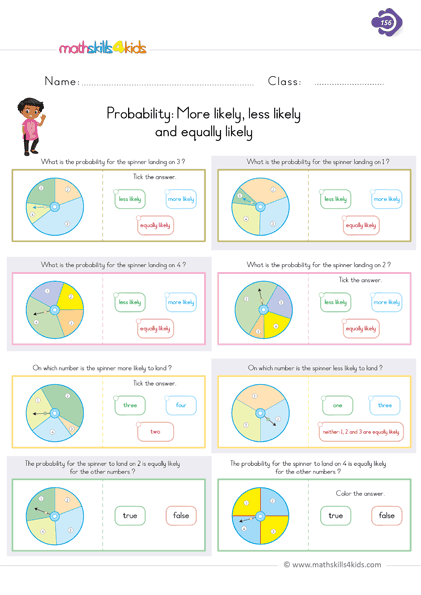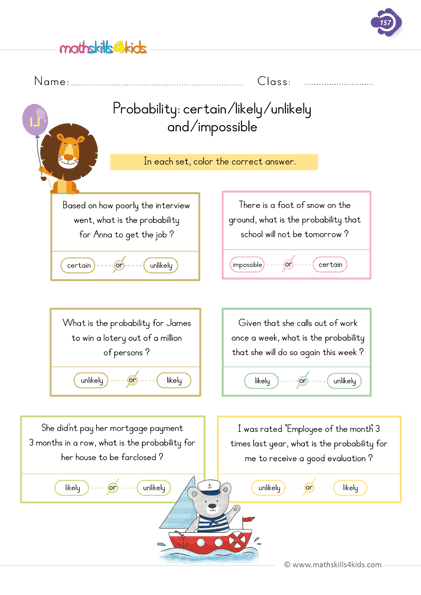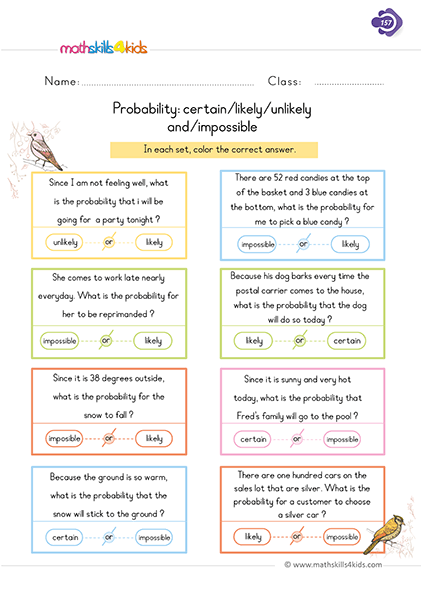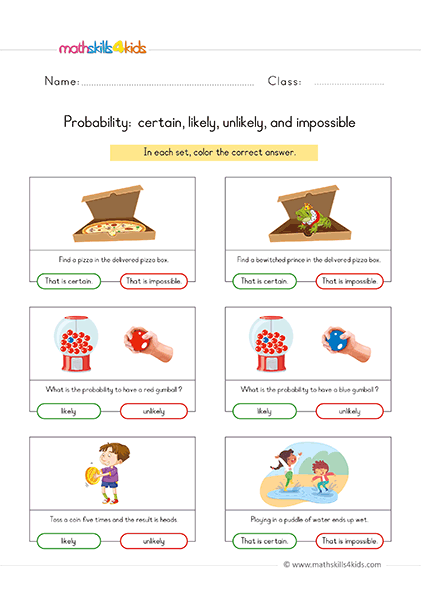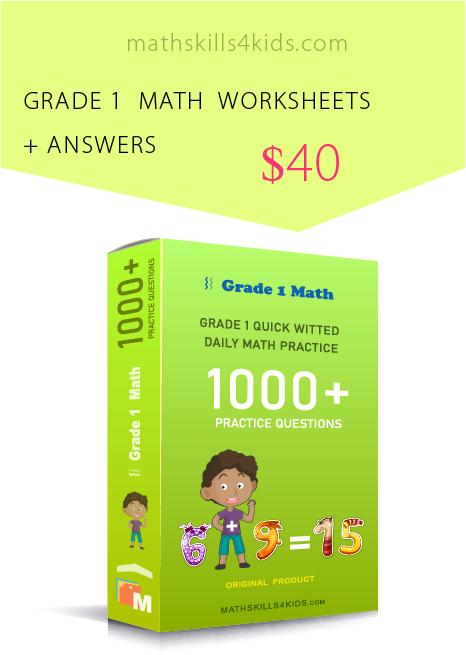Fun Probability Worksheets for 1st Grade: Free Printables
-
Teaching probability to a 1st grader can be a fun and engaging experience with the right resources. So, we are here to encourage teachers and parents to grasp this mind-blowing fun probability worksheets for 1st Graders and help them easily understand the basics of probability. These free printable probability worksheets from Mathskills4kids offer various stimulating activities about uncertain situations that will keep your kids entertained while learning.
These worksheets are a great way to make learning fun, from rolling dice to flipping coins. You can download and use these worksheets with your kids at home.
Why probability matters for your first grader?
way? Here are some tips:
Probability is the study of the likelihood or chance of an event occurring. Besides, after going through this resource, you'll realize that early mastering probability skills matters a lot for your first grader. First, it connects math and real-life areas, like counting, predicting the weather or the outcome of a sports game, geometry, etc.
Also, introducing probability to 1st graders can help them develop critical thinking skills and understand the world around them.
Our fun and engaging probability worksheets are thus a great way to start!
-
BROWSE THE WEBSITE
-
DOWNLOAD FREE WORKSHEETS
-
-
1st GRADE MATH TOPICS
- Counting and numbers
- Understand addition
- Addition skills
- Addition exercises
- Addition strategies
- Understand subtraction
- Subtraction skills
- Subtraction Exercises
- Subtraction strategies
- Mixed operation
- Comparing numbers up to 100
- Estimation Worksheets
- Place value
- Spatial sense
- Graphing & data
- Measurement
- Patterns
- Probability
- Sorting & classifying
- Telling time
- 2D shapes
- 3D shapes - Solids figures
- Fractions
-
-
How to teach probability concepts with everyday objects and activities
Probability with Dice.
Introducing probability with dice is a great way to enhance and build on your 1st grader's probability skills. Start with a single die and have your child roll it several times, recording the results.
Ask them questions like, "What is the likelihood of rolling a 6?" or "What is the likelihood of rolling an even number?" Then, move on to using two dice and asking questions like, "What is the likelihood of rolling a total of 7?"
These activities will help your child understand the concept of probability in a fun and interactive way.
Probability with Spinners.
Another fun way to teach probability to 1st graders is by using spinners. Create a spinner with different colors or numbers and have your child spin it multiple times, recording the results each time.
Ask questions like, "What is the likelihood of landing on blue?" or "What is the likelihood of landing on an odd number?"
This activity will help your child understand the concept of probability and also improve their fine motor skills as they spin the spinner.
Probability with Coins.
Teaching probability to 1st graders can be a fun and engaging activity using coins. Start by showing your child the difference between heads and tails on a coin.
Then, flip the coin and ask questions like, "What is the likelihood of landing on heads?" or "What is the likelihood of landing on tails?" You can also have your child flip the coin multiple times and record the results to see if they match the expected probability.
This activity will help your child understand the concept of probability and also improve their counting skills.
Probability with Cards.
Another fun way to teach probability to 1st graders is by using playing cards. Start by showing your child the different suits and numbers on the cards.
Then, ask questions like, "What is the likelihood of drawing a red card?" or "What is the likelihood of drawing a card with the number 5?" You can also have your child draw multiple cards and record the results to see if they match the expected probability.
This activity will help your child understand the concept of probability and also improve their math skills.
-
Fun probability worksheets for 1st Grade: Free printables
These worksheets are designed to help your child learn the basic vocabulary and probability concepts in a fun and interactive way. They also include colorful pictures and examples that appeal to your child's interests and curiosity.
Let's take a look at each worksheet in more detail!
Worksheet 1: More likely and less likely
This worksheet introduces your child to compare the likelihood of different events. For example, is it more likely or less likely to rain on a sunny day than on a cloudy day? Is it more or less likely to roll a 6 on a dice than a 1?
Your child must circle the correct answer for each question and explain their reasoning. This will help them develop their critical thinking and communication skills.
Worksheet 2: Impossible and possible
This worksheet teaches your child the difference between impossible and possible events. For example, is seeing a unicorn in real life impossible or impossible? Is it impossible or possible to have two birthdays in one year?
Your child must write "impossible" or "possible" for each statement and explain why. This will help them understand the meaning of these words and how to use them correctly.
Worksheet 3: Certain, likely, unlikely, and impossible
This worksheet expands your child's probability vocabulary by introducing them to four more words: certain, likely, unlikely, and impossible. For example, is it certain, likely, unlikely, or impossible to get heads when you flip a coin? Is it certain, likely, unlikely, or impossible to find a four-leaf clover in a field?
Your child must match each word with its definition and then use it to complete each sentence. This will help them learn the definitions and usage of these words and how they relate.
Worksheet 4: Always, sometimes, never
This worksheet helps your child apply their knowledge of probability to everyday situations. For example, does it always, sometimes, or never snow in winter? Does it always, sometimes, or never rain when clouds are in the sky?
Your child will have to write "always," "sometimes," or "never" for each statement and explain why. This will help them practice their observational and logical skills.
-
How to check your child's understanding and progress
After your child completes each worksheet, you can check their answers using the answer key provided at the end of this blog post. You can also ask them follow-up questions to assess their understanding and progress. For example:
- How do you know if an event is more likely or less likely than another event?
- What are some examples of impossible and possible events in your life?
- How can you tell if an event is certain, likely, unlikely, or impossible?
- What are some things that always, sometimes, or never happen in your life?
You can also encourage your child to ask you questions about probability and share their own examples and experiences. This will help them deepen their learning and connect with the real world.
-
More resources and tips for teaching probability to young learners
If you want more resources and tips for teaching probability to young learners, here are some suggestions:
- Read books about probability with your child. Some examples are: "Probably Pistachio" by Stuart J. Murphy, "That's a Possibility!" by Bruce Goldstone, "The Boy Who Loved Math: The Improbable Life of Paul Erdos" by Deborah Heiligman.
- Play games that involve probability with your child. Some examples are coin flipping, dice rolling, card drawing, spinner spinning, and rock-paper-scissors.
- Use manipulatives and objects that illustrate probability with your child. Some examples are marbles in a jar, colored candies in a bag, and buttons in a bowl.
- Use online tools and apps that simulate probability with your child. Some examples are Probability Simulator by Math Playground (https://www.mathplayground.com/probability.html), Probability Fair by PBS Kids (https://pbskids.org/cyberchase/math-games/probability-fair/), Probability Lab by PhET Interactive Simulations (https://phet.colorado.edu/en/simulation/probability).
- Have fun and be creative with your child. Probability is a fascinating and fun topic that can spark your child's curiosity and imagination.
You can explore different scenarios and questions with your child and see what they come up with. You can also challenge them to create their own probability worksheets and games for you to try.
More resources and tips for teaching probability to young learners
If you want more resources and tips for teaching probability to young learners, here are some suggestions:
- Read books about probability with your child. Some examples are: "Probably Pistachio" by Stuart J. Murphy, "That's a Possibility!" by Bruce Goldstone, "The Boy Who Loved Math: The Improbable Life of Paul Erdos" by Deborah Heiligman.
- Play games that involve probability with your child. Some examples are coin flipping, dice rolling, card drawing, spinner spinning, and rock-paper-scissors.
- Use manipulatives and objects that illustrate probability with your child. Some examples are marbles in a jar, colored candies in a bag, and buttons in a bowl.
- Use online tools and apps that simulate probability with your child. Some examples are:
Probability Simulator by Math Playground (https://www.mathplayground.com/probability.html)
Probability Fair by PBS Kids (https://pbskids.org/cyberchase/math-games/probability-fair/)
Probability Lab by PhET Interactive Simulations (https://phet.colorado.edu/en/simulation/probability).
- Have fun and be creative with your child. Probability is a fascinating and fun topic that can spark your child's curiosity and imagination.
You can explore different scenarios and questions with your child and see what they come up with. You can also challenge them to create their own probability worksheets and games for you to try.
Thank you for sharing the links of MathSkills4Kids.com with your loved ones. Your choice is greatly appreciated.
We hope you and your child enjoy these fun probability worksheets for 1st grade. They are free to download and print from the link below.
Happy learning!
-
